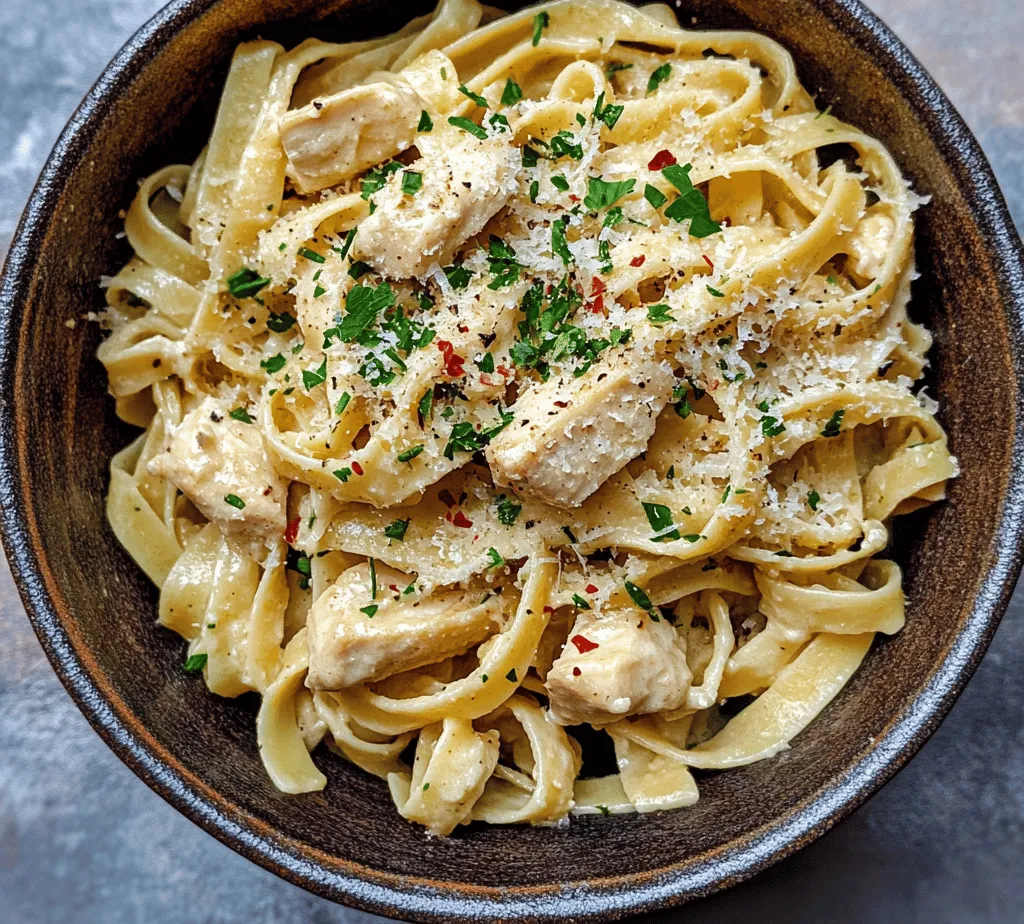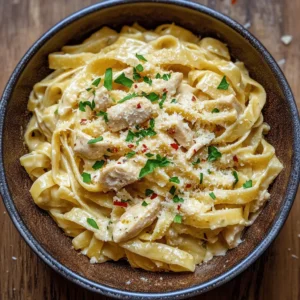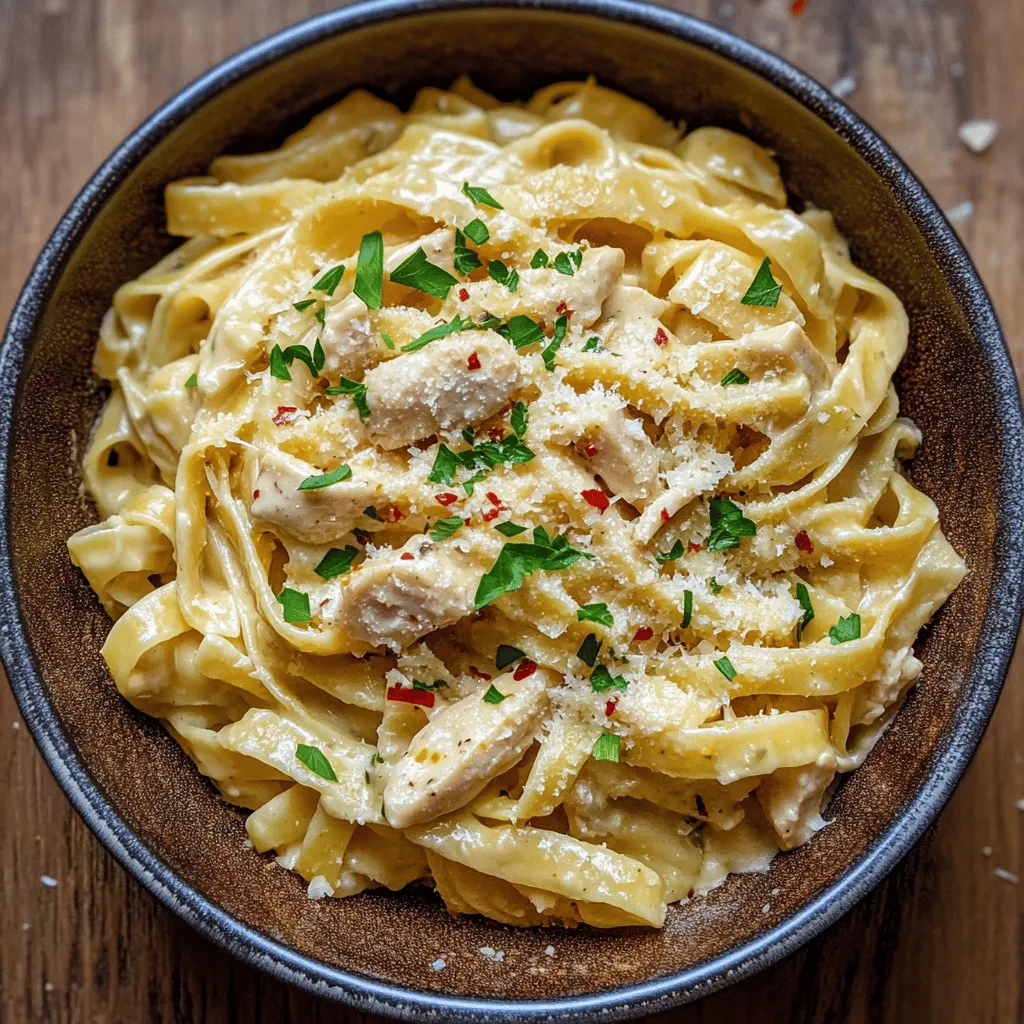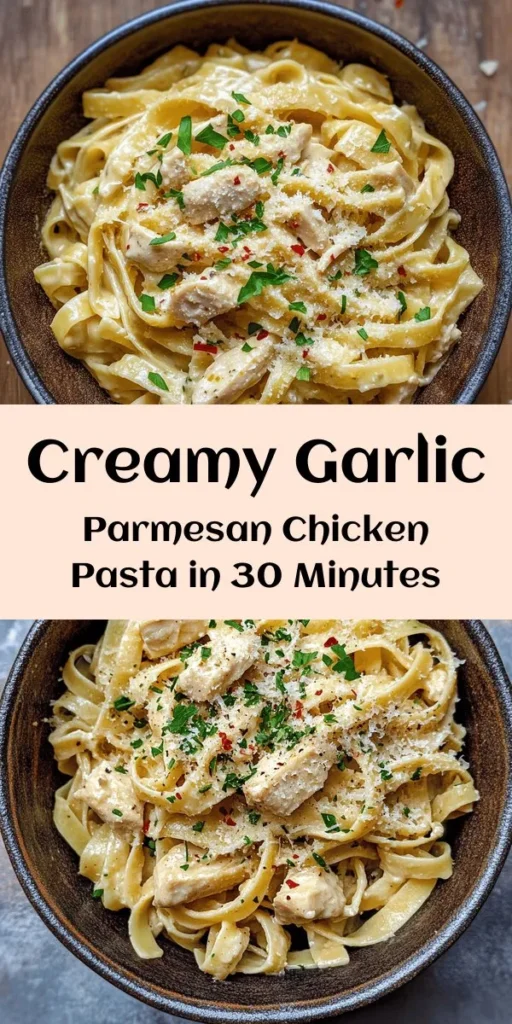Introduction
If you’re looking for a comforting and delicious meal to warm your soul, look no further than creamy chicken garlic Parmesan pasta. This dish combines tender chicken, perfectly cooked pasta, and a rich, creamy sauce infused with garlic and Parmesan cheese. It’s a delightful medley of flavors that caters to both the palate and the heart, making it an ideal choice for family dinners, weeknight meals, or a special occasion.
Creamy pasta dishes hold a cherished place in comfort food culture across the globe. They provide not just nourishment but also a sense of warmth and satisfaction that can brighten even the gloomiest of days. The luxurious texture of the cream, the savory depth of the garlic, and the sharpness of the Parmesan create a harmonious balance that tantalizes the taste buds. Each bite is a celebration of flavor, making this creamy chicken garlic Parmesan pasta a dish worth mastering.
In this recipe, we’ll explore how to create this delectable pasta dish step by step, ensuring that you achieve the perfect balance of flavors and textures that will have everyone asking for seconds. Let’s dive into the ingredients that bring this dish to life.
Understanding the Ingredients
To create a delicious creamy chicken garlic Parmesan pasta, understanding each ingredient’s role is crucial. Here’s a closer look at the main components of this recipe:
Chicken
The star of the dish, chicken provides a lean source of protein that enhances the dish’s heartiness. For this recipe, boneless, skinless chicken breasts or thighs are recommended. Chicken thighs offer a richer flavor and juiciness, while chicken breasts are leaner and cook faster. Either choice ensures your dish remains tender and flavorful.
Garlic
Garlic is more than just an aromatic; it’s a flavor powerhouse that elevates dishes with its pungent, savory notes. In this recipe, fresh garlic cloves are sautéed to release their natural oils, infusing the dish with a fragrant aroma and a robust flavor that pairs beautifully with creamy sauces. Garlic not only enhances taste but also offers health benefits, including anti-inflammatory properties and heart health support.
Parmesan Cheese
Parmesan cheese is a key ingredient that adds a rich, nutty flavor and creamy texture to the sauce. This aged cheese melts beautifully, creating a velvety consistency that clings to the pasta. Its sharpness balances the cream’s richness perfectly. Additionally, Parmesan is a good source of calcium and protein, making it a nutrient-dense choice for this dish.
Pasta
The type of pasta you choose can significantly affect the final dish. For creamy chicken garlic Parmesan pasta, fettuccine or penne works exceptionally well, as these shapes hold onto the sauce beautifully. The pasta acts as the perfect canvas for the creamy sauce, ensuring that every bite is a delightful amalgamation of pasta, chicken, and sauce.
Heavy Cream
Heavy cream is the backbone of the creamy sauce. Its high-fat content creates a luxurious texture, making the dish rich and satisfying. When combined with chicken broth, it forms a silky sauce that envelops the pasta and chicken. Heavy cream is also a source of vitamins A and D, adding a nutritional boost to your meal.
Chicken Broth
Chicken broth complements the heavy cream, adding depth and enhancing the overall flavor profile. It provides a savory base that balances the richness of the cream, ensuring that the sauce is not overly heavy. Using low-sodium chicken broth allows you to control the saltiness of the dish, keeping it flavorful without overwhelming the palate.
Step-by-Step Cooking Instructions
Now that we’ve covered the essential ingredients, let’s get into the step-by-step instructions for crafting your creamy chicken garlic Parmesan pasta. Follow these steps to ensure a delicious outcome.
Cooking the Pasta
1. Boil the Water: Start by bringing a large pot of water to a rolling boil. The amount of water should be ample enough to allow the pasta to move freely while cooking.
2. Salt the Water: Once the water is boiling, add a generous amount of salt. This is a crucial step; salting the water enhances the pasta’s flavor, ensuring it’s seasoned from the inside out. A good rule of thumb is to use about 1 tablespoon of salt per gallon of water.
3. Add the Pasta: Add your chosen pasta to the boiling water and stir immediately to prevent sticking. Cook according to the package instructions until al dente, usually between 8 to 12 minutes, depending on the pasta type.
4. Check for Doneness: To achieve the perfect al dente texture, taste the pasta a minute or two before the suggested cooking time. It should be firm to the bite but not hard. Remember, the pasta will continue to cook slightly after draining, so err on the side of undercooking it just a bit.
5. Reserve Pasta Water: Before draining the pasta, reserve about a cup of the starchy pasta water. This can be used later to adjust the sauce’s consistency if needed.
6. Drain and Set Aside: Drain the pasta in a colander and set it aside while you prepare the chicken and sauce.
Cooking the Chicken
1. Select the Chicken Cuts: For this recipe, boneless, skinless chicken breasts or thighs are recommended. If using breasts, consider slicing them in half horizontally to ensure even cooking and tenderness.
2. Season the Chicken: Season the chicken pieces generously with salt and pepper. This step is essential for flavor, as the seasoning will penetrate the meat during cooking.
3. Heat the Oil: In a large skillet or sauté pan, heat a tablespoon of olive oil over medium-high heat until shimmering. The oil should be hot enough that the chicken sizzles when added.
4. Cook the Chicken: Place the chicken into the pan, ensuring not to overcrowd it. Cook for about 5-7 minutes per side, or until the chicken is golden brown and reaches an internal temperature of 165°F. Use tongs to flip the chicken, ensuring it develops a nice crust without burning.
5. Let It Rest: Once cooked, transfer the chicken to a plate and let it rest for a few minutes. This resting period allows the juices to redistribute, ensuring your chicken is moist and flavorful.
Sautéing Garlic
1. Prepare the Garlic: While the chicken rests, mince several cloves of fresh garlic. Fresh garlic yields a more potent flavor compared to pre-minced varieties.
2. Sauté the Garlic: In the same skillet used for the chicken (do not wipe it out), lower the heat to medium. Add a touch more olive oil if needed, then add the minced garlic. Sauté for about 30 seconds to 1 minute, stirring constantly. This quick cooking releases the garlic’s flavor but be careful not to let it burn, as burnt garlic can impart a bitter taste.
3. Combine with Chicken: Once the garlic is fragrant, return the cooked chicken to the skillet, cutting it into bite-sized pieces if desired. Stir to combine, allowing the garlic to coat the chicken.
Making the Sauce
1. Add Cream and Broth: Pour in the heavy cream and chicken broth, stirring to combine. Bring the mixture to a gentle simmer, allowing it to bubble softly.
2. Adjust the Consistency: If the sauce seems too thick, add a splash of the reserved pasta water to loosen it. Continue to simmer for 3-5 minutes, allowing the flavors to meld and the sauce to thicken slightly.
3. Check Seasoning: Taste the sauce and adjust the seasoning with salt and pepper as needed. This step ensures the sauce is well-balanced and flavorful.
Adding Cheese and Seasoning
1. Incorporate Parmesan: Gradually add freshly grated Parmesan cheese to the sauce, stirring continuously. The cheese will melt into the sauce, creating a creamy texture and rich flavor.
2. Emulsify the Sauce: If the sauce appears too thick, add a little more pasta water until you reach your desired consistency. The starchy pasta water helps to emulsify the sauce, making it silky and cohesive.
3. Finishing Touches: Once the cheese has melted and the sauce is smooth, add the cooked pasta to the skillet. Toss everything together, ensuring the pasta is evenly coated with the creamy sauce.
By following these detailed steps, you can create a comforting and delicious creamy chicken garlic Parmesan pasta that is sure to impress. In the next part of this article, we will expand on tips for achieving the best results and answer some common questions about this dish. Stay tuned!

Balancing Flavors with Italian Seasoning and Optional Heat
To achieve a harmonious flavor profile in your Creamy Chicken Garlic Parmesan Pasta, the addition of Italian seasoning is essential. This classic blend, typically consisting of oregano, basil, thyme, and rosemary, brings a depth that complements the richness of the cream and the savory notes of the chicken. You can start with a teaspoon of Italian seasoning, adjusting to your taste as you cook.
For those who appreciate a little heat, consider adding red pepper flakes or crushed chili peppers. A pinch can elevate the dish and provide a delightful contrast to the creaminess. Remember, the key is to balance the flavors without overpowering the main elements. Start small and taste as you go, ensuring that the seasoning enhances rather than overwhelms the pasta.
Combining Chicken and Pasta
Once your sauce has reached the desired consistency, it’s time to marry your chicken and pasta. Begin by adding the cooked pasta directly into the skillet with the creamy sauce. The warmth of the pasta will help integrate the flavors. If you have not done so already, slice your cooked chicken into bite-sized pieces and add it to the skillet as well.
Using tongs or a large spoon, gently toss the pasta and chicken together. This step is crucial; you want each piece of pasta and chicken to be coated evenly with the sauce. If the mixture appears too thick, you can add a splash of reserved pasta water (more on this below) to loosen it up. The goal is to create a cohesive dish where every bite offers a delightful blend of chicken, pasta, and sauce.
Techniques for Ensuring Even Coating of Sauce
To achieve an even coating of the creamy sauce on your pasta, consider the following techniques:
1. Tossing Method: Instead of stirring, use a tossing motion with your tongs or spoon. This technique allows the pasta to gently lift and fall, helping the sauce to cling to it without breaking the noodles.
2. Pasta Water: As mentioned, reserved pasta water is a secret weapon. The starch in the water helps bind the sauce to the pasta, creating a silky texture. Start with a few tablespoons and add more as needed until you reach the desired consistency.
3. Heat Control: Ensure that your skillet is at a medium heat when combining the pasta and sauce. High heat can cause the cream to separate, while low heat may not allow the ingredients to combine effectively.
Importance of Using Reserved Pasta Water
One of the most overlooked yet crucial aspects of pasta preparation is the use of reserved pasta water. Before draining your pasta, set aside a cup of this starchy water. As you mix your chicken and pasta with the creamy sauce, add a little reserved water as needed. This not only helps to achieve the perfect sauce consistency but also enhances the overall flavor of the dish, making it more cohesive and luxurious.
The starch in the pasta water helps emulsify the sauce, creating a glossy finish that clings to each piece of pasta. This technique is often used by professional chefs, and once you try it, you’ll understand why it’s a game-changer in pasta recipes.
Serving Suggestions
When it comes to serving your Creamy Chicken Garlic Parmesan Pasta, presentation can elevate the dining experience. Here are some suggestions to make your dish stand out:
– Plate Individually: Serve the pasta in individual bowls rather than family-style. This allows each guest to appreciate the dish’s presentation, and it can help with portion control.
– Layering: For a more elegant presentation, you can layer the pasta. Start with a base of creamy sauce, add pasta, then top with chicken, and finish with more sauce to create visual interest.
– Warm Bowls: Serve the pasta in warmed bowls to keep the dish hot longer. Simply run the bowls under hot water or place them in a low oven for a few minutes before serving.
Presentation Tips for an Appealing Dish
The visual appeal of your Creamy Chicken Garlic Parmesan Pasta can be enhanced through thoughtful presentation. Here are a few techniques to consider:
– Color Contrast: Use bright garnishes to contrast the creamy tones of the pasta. Fresh herbs like parsley or basil add a pop of color and freshness.
– Cheese Finish: After plating, sprinkle a generous amount of freshly grated Parmesan cheese on top. Not only does it add flavor, but it also creates a beautiful finishing touch.
– Drizzle of Olive Oil: A light drizzle of high-quality olive oil can enhance both the flavor and the appearance of the dish. It adds a glossy sheen that makes the pasta look even more appetizing.
Garnishing Ideas for Enhanced Flavor and Visual Appeal
Garnishing is an essential part of presenting your Creamy Chicken Garlic Parmesan Pasta. Here are some ideas to elevate both the flavor and the visual appeal:
– Herbs: Freshly chopped parsley or basil can add brightness and a hint of freshness. Scatter them over the top just before serving for the best flavor and color.
– Lemon Zest: A sprinkle of lemon zest adds a refreshing citrus note that complements the creaminess of the pasta, brightening the overall dish.
– Toasted Nuts: For added texture and flavor, consider sprinkling toasted pine nuts or walnuts on top. The crunch creates a delightful contrast to the creamy pasta.
Flavor Variations
While the classic Creamy Chicken Garlic Parmesan Pasta is undeniably delicious, there are numerous ways to customize this recipe to suit your tastes:
Exploring Optional Ingredients and Variations
– Cheese Choices: While Parmesan is traditional, consider mixing in other cheeses like Gruyère or goat cheese for a different flavor profile. Each cheese brings its unique character to the dish.
– Herb Variations: In addition to Italian seasoning, try adding fresh thyme or oregano, or even a touch of dill for a unique twist.
Suggestions for Adding Vegetables
Incorporating vegetables not only enhances the nutritional value of the dish but also adds color and texture:
– Spinach: A handful of fresh spinach can be stirred in at the end of cooking. It wilts quickly and adds a lovely green color along with essential vitamins.
– Mushrooms: Sautéed mushrooms contribute an earthy flavor that pairs wonderfully with the cream and chicken.
– Broccoli or Peas: These vegetables add a pop of color and can be easily added during the last few minutes of cooking.
Alternatives for Protein
If you’re looking to switch things up, consider these alternatives for your protein source:
– Shrimp: Quick-cooking shrimp can be sautéed alongside the garlic, adding a seafood twist to the dish.
– Tofu: For a vegetarian option, tofu can be cubed and sautéed until golden, absorbing the flavors of the sauce beautifully.
– Bacon or Sausage: For a heartier option, crispy bacon or Italian sausage can add a savory depth to the dish.
Exploring Different Pasta Types and Their Flavor Profiles
The type of pasta you choose can significantly impact the dish’s texture and flavor:
– Fettuccine: This wider pasta allows for more sauce adherence, making each bite creamy and delicious.
– Penne: The tubular shape of penne allows sauce to fill the pasta, offering a delightful combination of flavors in every bite.
– Gluten-Free Options: For those with dietary restrictions, gluten-free pasta varieties are widely available and can be substituted without sacrificing taste.
Cooking Tips for Perfecting the Dish
While the Creamy Chicken Garlic Parmesan Pasta is straightforward, there are common pitfalls to avoid and tips to ensure perfection:
Common Mistakes to Avoid When Making Creamy Pasta
– Overcooking the Pasta: Always cook your pasta al dente; it will continue cooking slightly when combined with the sauce. Overcooked pasta can become mushy and lose its texture.
– High Heat: Cooking the cream sauce on too high a heat can cause it to separate. Always keep the heat at medium or low when incorporating the cream.
– Skipping the Pasta Water: Forgetting to reserve and use pasta water can lead to a thick, clumpy sauce. Always remember this crucial ingredient.
Tips for Making Ahead and Reheating Without Losing Creaminess
If you plan to make the dish ahead of time, here are some tips:
– Prepare the Components Separately: Cook the pasta and chicken but keep them separate from the sauce until ready to serve. This prevents the pasta from soaking up too much sauce and becoming dry.
– Reheating: When reheating, do so gently over low heat. Add a splash of reserved pasta water or additional cream to restore the sauce’s creaminess.
Storage Recommendations and Shelf-Life of Leftovers
Leftovers can be stored in an airtight container in the refrigerator for up to three days. For longer storage, consider freezing the dish:
– Freezing: Allow the pasta to cool completely before transferring it to a freezer-safe container. It can be stored for up to two months. When ready to eat, thaw overnight in the refrigerator and reheat gently.
Cultural Context and Popularity
Creamy pasta dishes have found a beloved place in many cuisines around the world. The comforting nature of a rich, creamy sauce combined with pasta makes it a favorite among home cooks and restaurant menus alike.
The Role of Comfort Food in Modern Dining Experiences
Today, comfort food has taken on new significance. Dishes like Creamy Chicken Garlic Parmesan Pasta offer an escape from the fast-paced world, providing warmth and satisfaction. They are often shared during family gatherings, celebrations, or simply as a treat after a long day.
How This Recipe Fits into Family Gatherings and Weeknight Dinners
The versatility and ease of preparation make this creamy pasta a perfect choice for family dinners. It can be whipped up in under 30 minutes, making it ideal for busy weeknights. Additionally, its rich flavor profile appeals to both adults and children alike, ensuring it will be a hit at the dinner table.
Conclusion
Creamy Chicken Garlic Parmesan Pasta is not just a meal; it’s an experience that brings comfort and joy to the dining table. With its rich flavors and easy preparation, it’s a dish that can be enjoyed on any occasion, from casual weeknight dinners to special family gatherings.
Encouraging you to try making this recipe at home, remember that the joy of cooking lies in the sharing of delicious meals with loved ones. So gather your ingredients, put on your apron, and savor the satisfaction of creating a comforting dish that’s sure to delight everyone around your table. Happy cooking!



